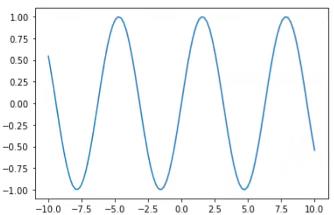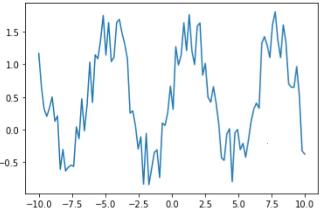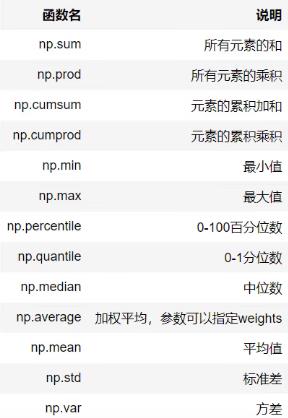Numpy基础(day2)随机函数及统计函数
Posted 啊~小 l i
tags:
篇首语:本文由小常识网(cha138.com)小编为大家整理,主要介绍了Numpy基础(day2)随机函数及统计函数相关的知识,希望对你有一定的参考价值。
Numpy常用random随机函数汇总

import numpy as np np.random.seed(666)
- rand(d0,d1,…,dn)
返回数据在(0,1)之间,均具有均匀分布
np.random.rand(5)
np.random.rand(3, 4)
np.random.rand(3, 4, 5) - randn(d0,d1,…,dn)
返回数据具有标准正态分(均值为0,方差为1)
np.random.randn(5)
np.random.randn(3, 4)
np.random.randn(3, 4, 5) - randint(low[,hight,size,dtype])
生成随机整数,包含low,不包含high
如果不指定high,则从[0, low]中生成数字
np.random.randint(3)# 生成0-3之间的数,不包含3
np.random.randint(1, 10)
np.random.randn(10,30,size=(2,3,4))# 10到30之间的整数(分为两块,每块为三行四列) - random([size])
生成[0.0,1.0]的随机数
np.random.random(5)
np.random.random(size=(3, 4))
np.random.random(size=(3, 4, 5)) - choice(a[,size,replace,p])
a是一维数组,从它里面生成随机结果
np.random.choice(5, 3)a是数字,则从range(5)中生成 size为3
np.random.choice(5, (2,3))
np.random.choice([2,3,4,5,6,7],3)从数组里面随机取出数字 - shuffle(x)
把一个数组x进行随机排列
import numpy as np
x = np.arrange(10)
np.shuffle(x)
print(x)
a = np.arrange(10).reshape(4, 5)
np.shuffle(a) # 多维数组,则只会在第一维度打乱数据
print(a)
- permutation(x)
把一个数组x进行随机排列,或者数字的全排列
np.random.permutation(10)随机生成range(10)进行随机排列
arr = np.arrange.reshape((3,3))在第一维度进行打散
np.random.permutation(arr)创建一个新的copy,不修改原来的 - normal([loc, scale, size])
按照平均值loc和方差scale生成高斯分布的数字
np.random.normal(1,10,10)
np.random.normal(1,10,(3,4)) - uniform([low, high, size])
在[low,high)之间生成均匀分布的数字
np.random.uniform(1,10,10)
np.random.uniform(1,10,(3,4))
demo 对数组加入随机噪声
import matplotlib.pyplot as plt
# 绘制sin曲线
x = np.linspace(-10,10,100) # 指定最小数,最大数,生成的个数
y = np.sin(x)
plt.plot(x,y)
plt.show()
# 加入噪声
x = np.linspace(-10,10,100) # 指定最小数,最大数,生成的个数
y = np.sin(x)+np.random.rand(len(x))
plt.plot(x,y)
plt.show()
加入噪声前

加入噪声后

Numpy数学统计函数
- 常用统计函数

- 按不同的axis计算
以上的函数都有一个参数叫做axis用于指定计算轴还是列,如果不指定,就会计算所有元素结果
数学统计函数实例
import numpy as np
arr = np.arange(12).reshape(3, 4)
print(arr)
print(np.sum(arr)) # 求和 默认作为一维数组处理求和
print(np.prod(arr)) # 乘积
print(np.cumsum(arr)) # 第一位等于第一位,第二位等于第一位加第二位-----同理
print(np.cumprod(arr)) # 第一位等于第一位,第二位等于第一位乘第二位-----同理
print(np.min(arr)) # 最小值
print(np.max(arr)) # 最大值
print(np.percentile(arr, [25, 50, 75])) # 首先将数据从小到大排列,50 表示取位置为50%的数字,取值为[0-100]
print(np.quantile(arr, [0.25, 0.5, 0.75])) # 同上,但是取值为[0-1]
print(np.median(arr)) # 中位数
print(np.mean(arr)) # 平均值
print(np.std(arr)) # 标准差
print(np.var(arr)) # 方差
# weight的shape需要和arr一样
weight = np.random.rand(*arr.shape)
print(weight)
np.average(arr, weights=weight) # 加权平均值
numpy的axis的用途
axis=0代表行、axis=1代表列
- 按行求和
arr.sum(axis=0) - 按列求和
arr.sum(axis=1)
以上是关于Numpy基础(day2)随机函数及统计函数的主要内容,如果未能解决你的问题,请参考以下文章
人工智能数学基础--概率与统计10:离散随机变量的概率函数及常见的二项分布泊松分布
python基础2:随机数生成—random模块、numpy中的random函数